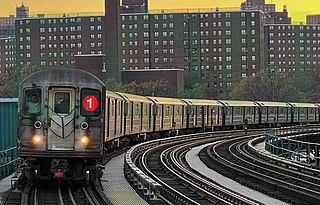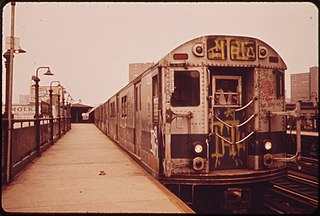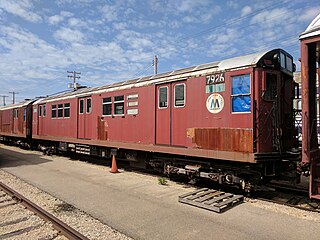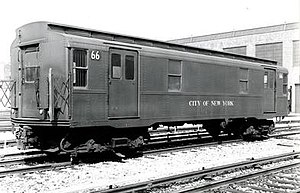
The R32 was a New York City Subway car model built by the Budd Company from 1964 to 1965 for the IND/BMT B Division. A total of 600 R32s were built, numbered 3350–3949, though some cars were re-numbered. The R32 contract was divided into two subcontracts of 300 cars each: R32 and R32A ; the former was paid by the city's capital budget and the latter was paid through a revenue bond. All were arranged as married pairs.

The R142 is the first mass-produced model class of the newest generation or new technology (NTT) A Division cars for the New York City Subway. It was built by Bombardier Transportation in La Pocatière, Quebec, Canada and Barre, Vermont, U.S. with final assembly performed at Plattsburgh, New York, from 1999 to 2003. There are 880 cars numbered 6301–7180 and another 150 cars numbered 1101–1250, for a total of 1,030 cars, all arranged as five-car sets. Together with the R142As, they replaced the Redbird trains, including the R26, R28, R29, R33, R33S, and R36.

The R44 is a New York City Subway car model built by the St. Louis Car Company from 1971 to 1973 for the B Division and the Staten Island Railway (SIR). The cars replaced many R1–9 series cars, and all remaining 1925 Standard Steel built SIRTOA ME-1 trains, providing Staten Island with a new fleet of railcars. The R44 fleet originally consisted of 352 cars, of which 56 remain in service, all on the Staten Island Railway.

The R42 was a New York City Subway car model built by the St. Louis Car Company between 1969 and 1970 for the IND/BMT B Division. There were 400 cars in the R42 fleet, numbered 4550–4949. It was the last 60-foot (18.29 m) B Division car built for the New York City Subway until the R143 in 2001, and the last car model class to be built in married pairs.

The R62 is a New York City Subway car model built between 1983 and 1985 by Kawasaki Heavy Industries in Kobe, Japan, for the A Division. A total of 325 cars were built, originally as single units. When the reliability of the fleet improved, they were converted to five-car sets. The cars replaced the remaining R12s, R14s, and R15s, which were all retired by the end of 1984.

The New York City Subway is a large rapid transit system and has a large fleet of electric multiple unit rolling stock. As of November 2016, the New York City Subway has 6418 cars on the roster.

The R1–9s were the 1,703 similar New York City Subway cars built between 1930 and 1940 for the Independent Subway System. All were built by the American Car and Foundry Company, the Pressed Steel Car Company, and Pullman Standard. The name "Arnines" comes from the literal spelling out of the final contract under which these 1,703 cars were ordered – contract "R9".
The IRT Dyre Avenue Line is a New York City Subway rapid transit line, part of the A Division. It is a branch of the IRT White Plains Road Line in the northeastern section of the Bronx, north of East 180th Street. As of 2013, it has a daily ridership of 34,802.

The R62A is a New York City Subway car model built between 1984 and 1987 by Bombardier Transportation for the A Division. The cars were built in La Pocatière, Quebec, with final assembly done in Auburn, New York and Barre, Vermont, under a license from Kawasaki Heavy Industries, manufacturer of the previous R62 order. A total of 825 cars were built, arranged as sets of three, four, or five cars per set. The cars replaced the remaining R17s, R21s, and R22s, which were all retired by early 1988.

The R6 was a New York City Subway car model built from 1935 to 1936 for the city-operated Independent Subway System by three manufacturers under separate orders, the American Car and Foundry Company, Pullman Standard, and Pressed Steel Car Company. A total of 500 cars were built, numbered 900–1399, and arranged as single units. There were three versions of the R6: R6-1, R6-2, and R6-3. The R6s were a continuation of the R4 fleet and look almost the same, except that the R6 had a two-pane front window compared to the R4's one-pane window.

The R10 was the first series of post-war New York City Subway cars. They were built by the American Car and Foundry Company from 1948 to 1949 for the IND/BMT B Division. A total of 400 cars were built, arranged as single units. Two versions were manufactured: Westinghouse (WH)-powered cars and General Electric (GE)-powered cars. The R10s introduced many innovations, including an all-welded low-alloy high tensile (LAHT) steel construction, dynamic braking, improved propulsion, and various cosmetic features.

The R21 was a New York City Subway car built by St. Louis Car Company from 1956 to 1957 for the IRT A Division. A total of 250 cars were built, arranged as single units. Two versions were manufactured: Westinghouse (WH)-powered cars and General Electric (GE)-powered cars.

The R33 was a New York City Subway car model that was built by St. Louis Car Company in 1962 and 1963. The cars are a "follow-up" or supplemental stock for the A Division's R29s and closely resemble them. The cars were also referred to as R33MLs to distinguish them from the R33Ss. A total of 500 cars were built, numbered 8806–9305, and arranged in pairs.

The R7 was a New York City Subway car model built from 1937 to 1938 for the city-operated Independent Subway System by two manufacturers under separate orders, the American Car and Foundry Company and Pullman Standard. They were a continuation of the R6 fleet and closely resemble them, except that the R7/As did not include the “CITY OF NEW YORK” lettering on the middle of the car exterior. A total of 250 cars were built, all arranged as single units. Two versions were ordered: the R7, which consisted of 150 cars, numbered 1400–1549, and the R7A, which consisted of 100 cars, numbered 1550–1649.

The R22 was a New York City Subway car built by the St. Louis Car Company from 1957 to 1958. The cars were a "follow-up" or supplemental stock for the A Division's R21s and closely resemble them. A total of 450 cars were built, arranged as single units. Two versions were manufactured: Westinghouse (WH)-powered cars and General Electric (GE)-powered cars.

The R28 was a New York City Subway car model built by American Car and Foundry (ACF) from 1960 to 1961. The cars were a "follow-up" or supplemental stock for the A Division's R26s and closely resemble them. The average car cost per R28 was $114,495. A total of 100 cars were built, arranged in married pairs.

The Standard Lo-V was a New York City Subway car type built from 1916 to 1925 by the Pressed Steel Car Company, American Car and Foundry, and Pullman Company for the IRT. A total of 1,020 cars were built, which consisted of 725 motors and 295 trailers. It was the third and most common "Lo-V" type car ordered for the IRT.

The MS Multi-section was a series of New York City Subway cars. They were built in prototype form in 1934 with production models built in 1936. Built by the Budd, Pullman, and St. Louis car companies, they were called "Multis" for short. They were so named because each car was an articulated car made of five sections; though the MS Multi-section fleet's lengths differed, their average length was 170 ft (52 m).

The ME-1 was an electric multiple unit subway car built from 1925 to 1926 by the Standard Steel Car Company for the Staten Island Rapid Transit Railway Company and later also used in the New York City Subway. 100 cars were built, numbered 300–389 (motors), and 500–509 (trailers). They were the first electric cars to run in revenue service on the SIRT.

Manhattan El is a term used to describe Interborough Rapid Transit Company (RT) elevated gate cars used on predecessor lines of the New York City Subway system. These cars were built by the Pullman, Wason, Gilbert & Bush, Bowers & Dure, Barney & Smith, Jewett, St. Louis, Cincinnati, and American Car and Foundry companies.



















